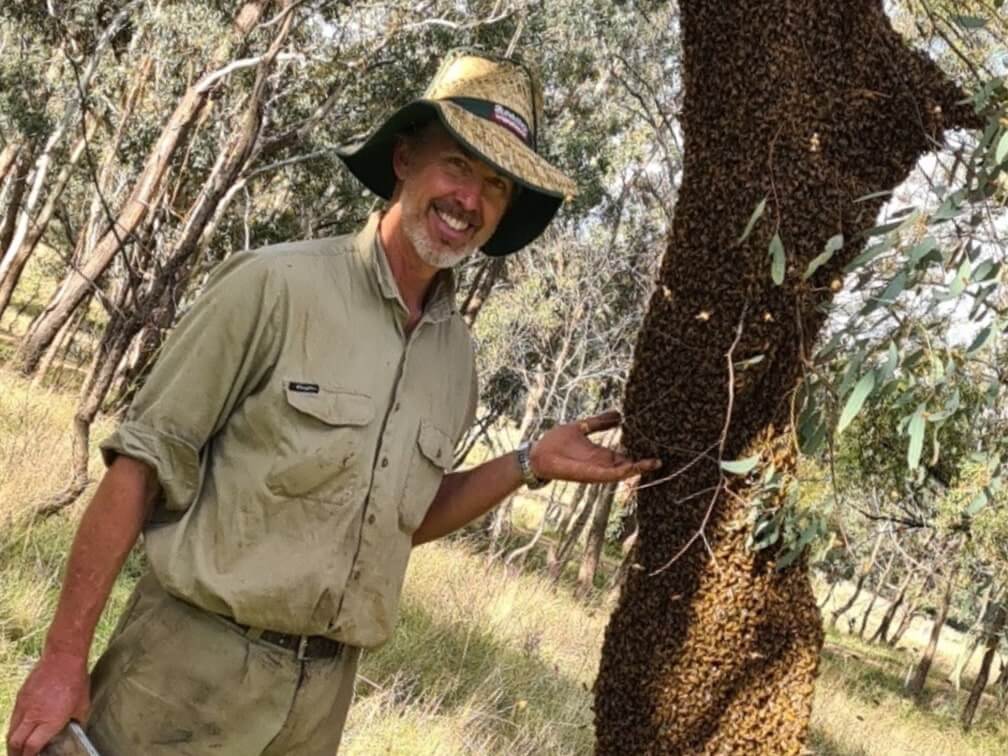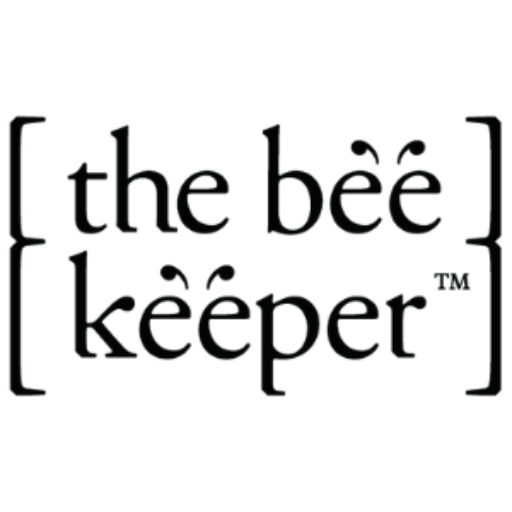
Help! there’s a bee swarm – NSW advice
Have you found a bee swarm in your garden or near a public area that is concerning you or you’d like removed?
Though we find bee swarms fascinating to watch (and there’s some amazing research out in New Scientist magazine that ‘bee swarms can generate more electricity per metre than a thunderstorm‘!), we totally understand that you might not be feeling so fascinated right now as tens of thousands of bees start making themselves comfortable on your garden furniture.
Not everyone is as comfortable with bees as our head beekeeper Daryl Brenton (see pic), so in addition to calls about where people can buy our delicious pure honey, we also get a lot of calls from people like you who have discovered a bee swarm in a trafficked area, such as near paths and entry doors…ie: bees hanging out in places that make people feel nervous or worried.
These swarm calls are along the lines of:
‘Help, there’s a bee swarm in a tree in my garden, what do I do?’
‘Bees are swarming in the playground near the kids, can you come quick?’
‘I’ve found a bee swarm in a bush near the front door, would you like to come collect it?’
‘Bees are swarming in my roof, I don’t want to spray them, can you come get them out of here?’
‘I’m allergic to bees and there’s a swarm at the front gate, can you please remove them?’
Firstly, we just want to let you know, though it’s natural to feel nervous when you come across a swarm of honey bees, there’s no need to panic. Sure, be careful (and take precautions, especially if you have a severe bee sting allergy) but please don’t bother or disturb them.
Usually bees hanging out in a tree, on a fence post or on a bush will move on after a day or two and you won’t need to do anything. That’s because they’re actually out scouting and looking for a new home – they don’t want to remain in an exposed place. Also, honeybee swarms are usually quite placid unless disturbed as they aren’t actually protecting a home…they’re looking for one.
Mostly bees swarm in Spring and Summer when conditions are good and they’ve outgrown their original home. The bees will split into two colonies, one staying in their current hive and the other off to set up a new home. It’s the ones looking for a new home that you will see swarming.
Unfortunately, we are not able to come out and assist with swarm removal on the Mid North Coast (Forster, Port Macquarie, Lake Cathie, Wauchope, Kempsey etc) for a few reasons – but we can point you in the right direction!
Why can’t The BeeKeeper® team help with swarm removal?
As professional beekeepers, we’re normally out with our own bees and can be working way out in different forests and along the coastline which makes it hard to pack everything up and travel to a swarm call. There’s also always something needing doing back at our home apiary too (such as honey extracting and bottling or melting beeswax into block form), or we might be selling our honey at the markets or dropping it into retail stores, or packing up online honey orders – so we just don’t have the resources to come out to every swarm call.
But bee swarm removal for us got even more complicated from 2022 with the varroa mite incursion. It’s now even more important that we keep our team of bees healthy and free of disease and pests. We practice top quality hygiene and checks on our bees, so we can’t work with swarms where we don’t know their origin or what diseases or pests they may be carrying. That’s because we (and certainly our bees!) don’t want to introduce pests and diseases into healthy hives.
Luckily though, there are some great amateur beekeepers who are happy to help with local swarm removal. And this is a great service as bees have it hard enough as it is and we really don’t want them and the environment being sprayed and poisoned when there’s no need to.
The best thing to do if you have a swarm that won’t move on after a few days, is to use the services of the NSW Amateur Beekeeping Association who have a directory of local amateur beekeepers who may be able to help with swarm removal.
In areas of NSW outside of the Hunter where you experience a bee swarm, just type in your postcode on the Swarms page on the Amateur Beekeepers website and details for any local beekeepers who can help you remove the bee swarm will pop up.
If you are in the Hunter Valley though, according to their website: The whole of New South Wales is currently subject to a Biosecurity Order restricting the transportation or handling of honey bees. As a result, in areas such as the Hunter Valley swarms cannot be collected, but must be reported. If you are aware of a swarm or other colony of honey bees in the Hunter Valley area it is vital that you report it to the Exotic Plant Pest Hotline on 1800 084 881 or use the online form at www.dpi.nsw.gov.au/hives.
We hope the bees move on of their own accord in a couple of days, but if not, an amateur beekeeper will be a great option.
Hope that information helps with information about swarm removal and thanks so much for caring about bees!

